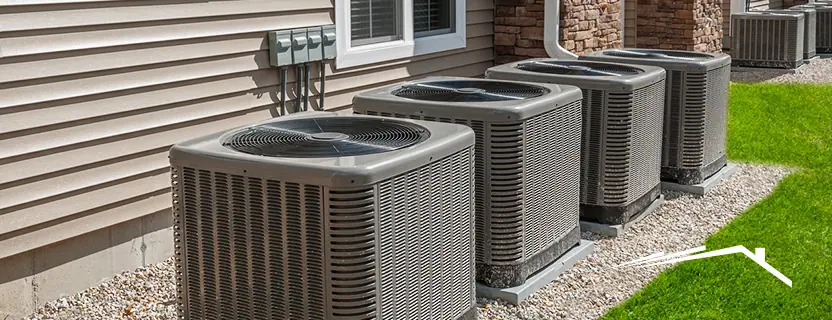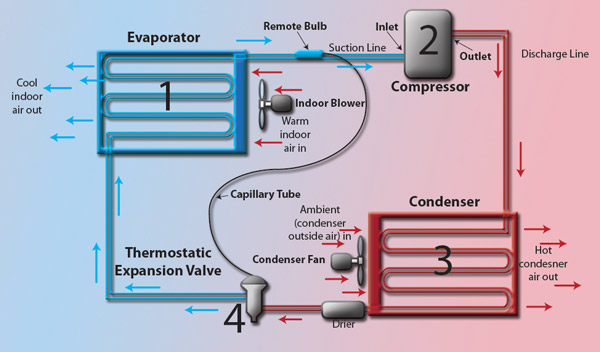Discovering the Essential Parts of an Efficient A/c System
A reliable cooling and heating system is constructed on numerous crucial parts that function in consistency. Each part, from the thermostat to the ductwork, plays an essential duty in maintaining comfort and energy efficiency. Recognizing these components is vital for optimizing performance and enhancing indoor air top quality. As one takes a look at these components, the detailed relationships between them disclose insights into improving overall system effectiveness. What particular elements contribute most to this effectiveness?
The Function of the Thermostat in A/c Effectiveness

Typically ignored, the thermostat plays an important function in the efficiency of HVAC systems. This small tool works as the primary control center, regulating temperature settings and making certain perfect convenience within a space. By accurately picking up the ambient temperature level, the thermostat communicates with the ventilation, air, and home heating conditioning devices to keep the desired environment
A reliable thermostat reduces energy intake by triggering the cooling and heating system just when essential, thus preventing extreme heating or air conditioning. Modern programmable and wise thermostats boost this efficiency better by enabling customers to set schedules and from another location adjust settings, adapting to everyday regimens.
Additionally, the positioning of the thermostat is important; inappropriate place can bring about incorrect temperature readings, causing ineffective operation. In general, a well-functioning thermostat not just enhances comfort yet also contributes noticeably to power savings and the longevity of the HVAC system.
Understanding the Value of Air Filters
Air filters serve a necessary function in a/c systems by assuring that the air flowing within a space remains tidy and healthy and balanced. These filters trap dust, allergens, and various other toxins, stopping them from being recirculated throughout the environment. By capturing these particles, air filters add to improved indoor air quality, which can greatly benefit passengers' health and wellness, especially those with allergies or respiratory system conditions.
Additionally, keeping tidy air filters improves the performance of cooling and heating systems. Blocked filters can restrict airflow, causing the system to function more challenging to maintain desired temperatures, resulting in enhanced power intake and greater utility bills. Consistently changing or cleaning up filters is an important upkeep action that can extend the lifespan of heating and cooling equipment. Ultimately, recognizing the significance of air filters permits homeowners and structure managers to take aggressive actions to assure a well-functioning, reliable HVAC system that advertises a comfortable and secure indoor environment.

The Functionality of the Furnace and Heatpump
Heaters and warm pumps are crucial elements of cooling and heating systems, in charge of offering heat during colder months. Heaters operate by home heating air with burning or electrical resistance, then dispersing it throughout the home through air ducts. They normally provide quick heating and can be fueled by gas, power, or oil, depending upon the system kind.
Conversely, heat pumps move warm as opposed to generate it. They remove heat from the outdoors air or ground, even in low temperatures, and move it indoors. HVAC experts. This double capability permits warmth pumps to also give cooling in warmer months, making them flexible choices for year-round climate control
Both systems need correct upkeep to assure efficiency and longevity. While heating systems succeed in extreme cool, heatpump can be advantageous in moderate environments. Recognizing their distinctive capabilities aids property owners in picking the most ideal option for their heating needs.
Discovering the A/c System
The air conditioning unit is a crucial part of HVAC systems, available in various types to match various requirements. Understanding the efficiency rankings of these units is crucial for making informed choices regarding power intake and cost. This section will explore the varied kinds of air conditioning system and clarify just how performance scores effect performance.
Kinds Of Air Conditioners
While different aspects influence the choice of cooling systems, recognizing the different types readily available is important for home owners and building supervisors alike. Central air conditioning conditioners are created to cool entire homes or buildings, making use of a network of air ducts for air flow. Window systems provide a more local service, suitable for tiny rooms or single rooms. Mobile air conditioning system give adaptability, permitting customers to relocate the system as needed. Ductless mini-split systems are another alternative, integrating the performance of central systems with the comfort of zoning, as they call for no ductwork. Ultimately, geothermal systems harness the earth's temperature level for energy-efficient air conditioning. Each type includes distinct benefits, making informed selections crucial for effective climate control.

Effectiveness Rankings Clarified
Comprehending effectiveness ratings is vital for picking the ideal cooling unit, as these metrics offer understanding right into the system's efficiency and energy consumption. The most common ranking for ac unit is the Seasonal Power Effectiveness Ratio (SEER), which gauges the cooling outcome throughout a normal cooling period divided by the overall electric power input. A higher SEER indicates much better performance. Additionally, the Power Efficiency Proportion (EER) is used for measuring efficiency under certain problems. One more important metric is the Power Star accreditation, which signifies that a system satisfies rigorous energy effectiveness standards. By assessing these rankings, consumers can make educated options that not only optimize convenience yet also reduce power prices and ecological effect.
The Relevance of Ductwork and Air movement
Efficient ductwork design and airflow management play essential functions in the overall effectiveness and efficiency of a/c systems. Proper ductwork assurances that conditioned air is dispersed equally throughout a space, minimizing temperature level variations and enhancing comfort. Well-designed ducts lessen resistance to air flow, minimizing the workload on a/c tools and inevitably decreasing power usage.
Air movement monitoring entails strategically placing vents and signs up to boost the circulation of air. This protects against usual issues such as warm or cool areas, which can take place when airflow is obstructed or improperly balanced. Furthermore, the ideal air duct materials and insulation can further enhance effectiveness by decreasing warm loss or gain during HVAC experts air transportation.
An efficient ductwork system not just adds to power financial savings yet can also extend the life-span of HVAC tools by lowering unnecessary pressure (HVAC experts). Consequently, recognizing the significance of ductwork and air movement is essential for achieving peak cooling and heating system efficiency
Regular Upkeep Practices to Improve Performance
Routine maintenance practices are essential for making certain peak performance of HVAC systems. These practices consist of routine inspections, cleansing, and needed repair work to maintain the system running effectively. Frequently transforming air filters is crucial, as blocked filters can block airflow and minimize efficiency. Additionally, service technicians should inspect and clean evaporator and condenser coils to avoid getting too hot and power wastefulness.
Annual specialist inspections are likewise recommended, as qualified specialists can recognize potential concerns prior to they escalate. Lubricating moving components reduces damage, contributing to a longer life-span for the system. Furthermore, guaranteeing that the thermostat works appropriately aids in preserving optimal temperature level control.

Often Asked Inquiries
How Commonly Should I Change My Thermostat?
Thermostats ought to commonly be replaced every 5 to more 10 years, depending upon usage and modern technology developments. Routine checks are suggested to guarantee peak performance, specifically if experiencing irregular temperature control or enhanced energy costs.
What Dimension Air Filter Is Ideal for My HVAC System?
The finest size air filter for a heating and cooling system differs by unit style. Commonly, it's essential to seek advice from the proprietor's guidebook or inspect the existing filter dimensions to assure peak performance and air quality.
Can I Install a Heatpump Myself?
Installing a heatpump individually is feasible for knowledgeable people, but it needs understanding of local codes and electrical systems. Hiring a professional is recommended to assure correct installation and perfect system efficiency.
Exactly how Do I Know if My Ductwork Is Reliable?
To determine ductwork performance, one must inspect for leakages, procedure airflow at vents, evaluate insulation high quality, and assess temperature level distinctions in between supply and return ducts. Professional assessments can provide detailed understandings right into overall performance.
What Are Indicators My HVAC Needs Immediate Upkeep?
Indications that an a/c system needs immediate maintenance include uncommon noises, irregular temperature levels, boosted energy costs, unpleasant smells, look at more info and constant cycling. Addressing these concerns immediately can prevent more damage and warranty top system efficiency.
Air filters serve an important feature in Heating and cooling systems by guaranteeing that the air distributing within an area continues to be tidy and healthy and balanced. In addition, preserving tidy air filters enhances the performance of Heating and cooling systems. Ductless mini-split systems are an additional option, incorporating the effectiveness of central systems with the comfort of zoning, as they call for no ductwork. Comprehending performance scores is vital for selecting the best air conditioning system, as these metrics provide insight into the system's efficiency and power usage. The ideal dimension air filter for an A/c system differs by device layout.